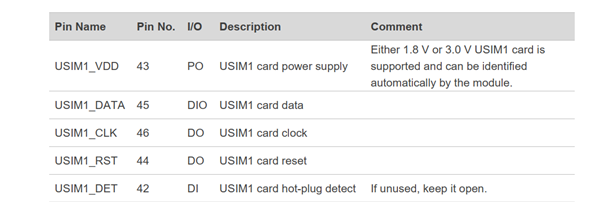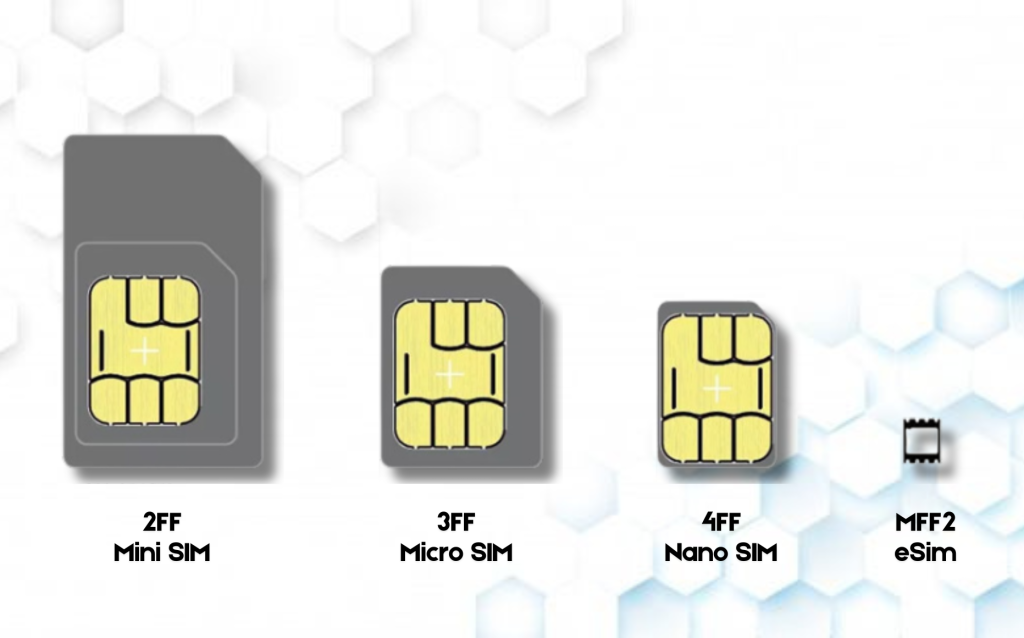An eSIM (embedded SIM) is an alternative to a traditional SIM (Subscriber Identity Module) card. Unlike traditional SIM cards, eSIMs do not require physical swapping to be reprogrammed for a different cellular network provider. In this blog, when we refer to eSIM, we mean an IC that can be soldered onto your PCB, such as the MFF2 (M2M Form Factor) shown in the photo.

Picture credit: digikey
Table of Content
ToggleWhy Use an eSIM in Your IoT Hardware Product?
eSIM is useful in IoT devices, especially applications where compact size or remote configurability is needed. There are three benefits eSIM offers over traditional SIM cards.
1. Smaller Size
It is approximately three times smaller, offering significant space savings. eSIM comes in an MFF2 form factor (typically 6 mm x 5 mm x 0.82 mm), which is considerably smaller than NanoSIM (12.3mm x 8.8mm x 0.67mm).
2. Remotely Configurable
No need to replace physical SIM card to change the network provider. This is also called remote provisioning of SIM profiles. This is useful for roaming in cross-border IoT applications or for optimizing data costs by changing the network provider.
3. Mechanically More Robust
Since it is soldered, it is more robust against shocks and vibrations compared to conventional SIM cards that are inserted in a SIM tray.
IoT/M2M eSIMs vs Consumer eSIM
Consumer eSIMs and IoT eSIMs are different.
The consumer eSIM standard is designed for devices like smartphones and tablets. It allows users to download SIM profiles using a QR code provided by the mobile operator. SIM profile is a certificate that enables a device to connect with the mobile operator’s cellular network. The user scans the code with the device’s camera, and the SIM profile is automatically downloaded. In this process, the end-user initiates the profile download.
In contrast, IoT eSIMs operate differently. IoT devices often cannot scan QR codes due to their limited capabilities. Instead, the IoT/M2M eSIM standard uses over-the-air (OTA) activation. Here, the profile download is usually managed remotely by the Remote SIM Provisioning (RSP) system, not by the device itself.
Before integrating an eSIM into your IoT device, ensure that you’re getting the IoT/M2M eSIMs.
Steps to Integrate eSIM in your IoT Hardware (Smart Device) Design
Here are the steps developers of IoT devices or embedded systems need to follow to integrate an eSIM into their design.
1. Verify if the regional providers support eSIM technology:
Before any hardware design, it is important to know about eSIM capability in the region where it is meant to be deployed. Identify the network operators that you’d get the service from and verify if they support eSIM in the region you plan to deploy the devices. Also, inquire your vendor about eSIM profile options, this is explained in this section.
2. Select an eSIM-supported wireless module:
When selecting the wireless connectivity module with cellular capabilities, it’s important to consider whether it includes built-in support for eSIM or if this functionality can be added using a module in addition to the wireless module. Two examples of wireless modules we used which have LTE/NB-IoT capability and support an external eSIM are Telit ME310 and Quectal EG916.

3. Understand the SIM hardware peripheral:
If the selected wireless module has an integrated SIM hardware peripheral, check for the electrical characteristics. Most SIM hardware peripherals allocate a configurable SIM VCC (1.8V/3.3V/5V) and correspondingly the voltage levels of the signals. The Quectel EG916 has the following electrical characteristics for the SIM hardware peripheral:

4. Interface eSIM with the wireless module:
eSIMs can be accessed using AT commands via clock/data lines. Typical connections are as follows:
RESET: Active low RESET
CLOCK: SIM clock signal
I/O: SIM data signal
VCC: SIM VCC (5V/3.3V/1.8V)
GND: SIM Ground

Ensure that you follow the schematic and PCB guidelines provided in the datasheets and application notes of eSIM as well as wireless module.
5. Enjoy the Connectivity
After you get your hardware (or prototype) assembled, it should be plug and play if your eSIM came with a profile. If your eSIM doesn’t come with a profile, check with the vendor about the activation process and read the section below.
Is a Profile Update in Your eSIM Possible? – Inquire Your Vendor About eSIM Profile Options:
Vendors (or telecom operators) offer eSIM variants based on different ways they can be configured. For example, support for multiple profiles or the option to update the profile later. Discuss with your vendor to choose the right eSIM according to your application requirements. Before finalizing, do check if the configuration option is supported by the wireless module as well. Here are typical configuration options:
1. Option 1 – multi-IMSI (with multiple network profiles):
This is easiest option available as it is a plug and play In multi-IMSI (International Mobile Subscriber Identity) eSIM, multiple profiles are already downloaded into the eSIM. The network can be switched depending upon the signal quality and region as eSIM automatically selects the suited network to operate on. This option doesn’t give you the flexibility to download any new profiles. For example, Telit Next Multi-IMSI in MFF2 format (4 IMSI donors).
Key features:
- Multiple profiles already on the eSIM
- No flexibility to download new profiles
- Plug and play, just like plastic SIM cards
2. Option 2a – eUICC (with one network profile):
This option comes with an operational profile already downloaded to the eSIM and gives you the option to update the profile later.
But you need to have an LPA (Local Profile Assistant) in your wireless module’s firmware to be able to download a new profile. Most available wireless modules don’t have built-in LPA support. For example, Telit’s ME310 doesn’t support LPA. But some, such as Telit ME910, do have built-in LPA support.
Key features:
- Flexibility to download any profile later.
- Requires LPAd (LPA in device).
3. Option 2b – eUICC (without a network profile):
This option comes without any operational profile on eSIM but a bootstrap profile which needs to be updated to an operational profile.
Please be aware that your wireless module firmware needs to have LPA (local profile assistant) support on to be able to download new profiles.
Key features:
- Flexibility to download any operator
- Requires LPAd (LPA in device)
- Factory provisioning possible with OTW workbench tool/ STM TruPhone connectivity (if blank eSIM or profile update is needed). Specialised tools are needed.
4. Option 3 – eUICC & LPAe supported:
This option also comes without any operational profile on eSIM but a bootstrap profile which needs to be updated to operational profile. The difference between a regular eUICC eSIM (Options 2a and 2b) and eUICC+LPAe supported eSIM (Option 3) is the presence of LPA (Local Profile Assistant) on eSIM. In case of LPAe, the LPA is integrated inside the eSIM directly to handle any profile downloads, thereby removing the dependency on your wireless module to download and handle new profiles. LPAe eSIMs are not widely available yet (as of 2024) but as they become prevalent, it may be a great solution for your eSIM needs because this eSIM has the ability to download a profile on its own, without any dependency on wireless module for LPA support.
Key features:
- LPAe, GSMA SGP.22 LPA inside the eSIM.
- No LPAd (LPA in device) needed
- Service fee involved.
Summary
eSIMs are embedded SIM cards that can be reprogrammed remotely, making them ideal for IoT devices. They are more compact, durable, and support remote network changes without physical swapping.
To integrate eSIMs into your IoT hardware:
- Check Regional Support: Verify that your target deployment region supports eSIM technology and confirm with network providers.
- Select a Compatible Module: Choose a wireless module that supports eSIM.
- Verify SIM Hardware Compatibility: Ensure the module’s SIM hardware interface matches the eSIM requirements.
- Follow Design Guidelines: Adhere to the datasheets and application notes for proper schematic and PCB design.
For profile management, understand the options available, such as multi-IMSI or eUICC. Check whether your wireless module supports LPA (Local Profile Assistant). Choose the configuration that best suits your application and discuss profile options with your eSIM vendor.
Abbreviations:
eSIM: Embedded SIM
eUICC. Embedded Universal Integrated Circuit Card
GSMA: Global System for Mobile Communications Association
IMSI: International Mobile Subscriber Identity
M2M: Machine to machine
MFF2: Machine to machine form factor
NB-IoT: NarrowBand-Internet of Things
SIM: Subscriber Identity Module
LPA: Local Profile Assistant


